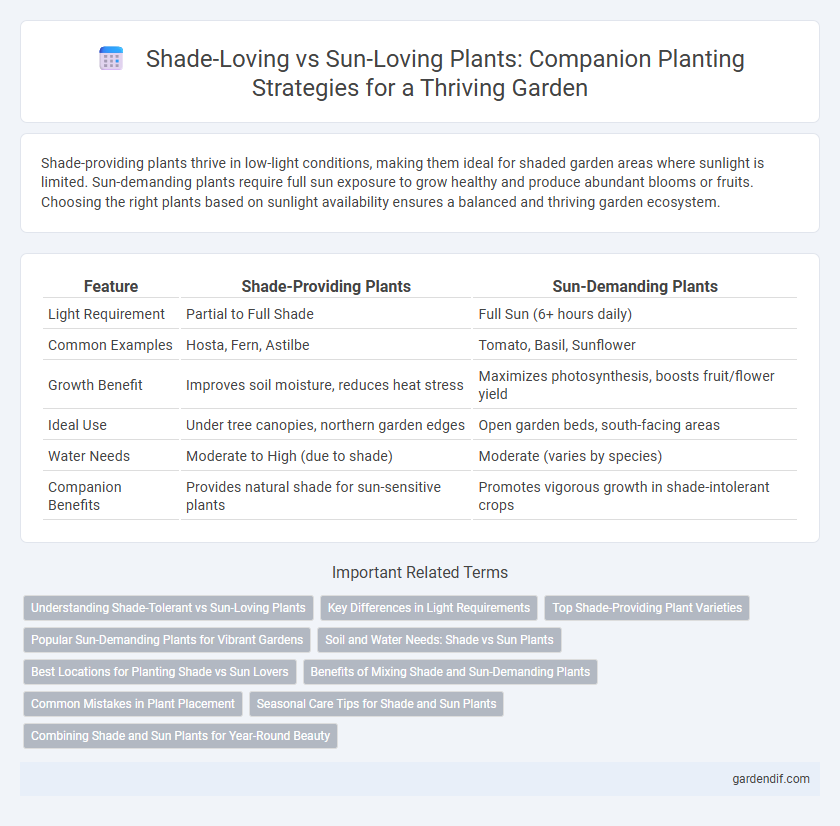
Shade providing plants vs sun-demanding plants Illustration
Shade-providing plants thrive in low-light conditions, making them ideal for shaded garden areas where sunlight is limited. Sun-demanding plants require full sun exposure to grow healthy and produce abundant blooms or fruits. Choosing the right plants based on sunlight availability ensures a balanced and thriving garden ecosystem.
Table of Comparison
| Feature | Shade-Providing Plants | Sun-Demanding Plants |
|---|---|---|
| Light Requirement | Partial to Full Shade | Full Sun (6+ hours daily) |
| Common Examples | Hosta, Fern, Astilbe | Tomato, Basil, Sunflower |
| Growth Benefit | Improves soil moisture, reduces heat stress | Maximizes photosynthesis, boosts fruit/flower yield |
| Ideal Use | Under tree canopies, northern garden edges | Open garden beds, south-facing areas |
| Water Needs | Moderate to High (due to shade) | Moderate (varies by species) |
| Companion Benefits | Provides natural shade for sun-sensitive plants | Promotes vigorous growth in shade-intolerant crops |
Understanding Shade-Tolerant vs Sun-Loving Plants
Shade-tolerant plants thrive in low-light conditions, adapting to reduced sunlight by optimizing photosynthesis with larger leaves and slower growth rates. Sun-loving plants require full sunlight for at least six hours daily, relying on intense light for energy production and vibrant blooms. Understanding the specific light requirements of each species ensures successful companion planting and garden health.
Key Differences in Light Requirements
Shade-providing plants thrive in low to indirect light conditions, adapting to environments with reduced sunlight by developing larger leaves and slower growth rates to maximize photosynthesis. In contrast, sun-demanding plants require full, direct sunlight for at least six hours daily and typically feature smaller, thicker leaves to minimize water loss and optimize energy capture. Understanding these key differences in light requirements helps in selecting appropriate companion plants that promote healthy growth and balanced garden ecosystems.
Top Shade-Providing Plant Varieties
Top shade-providing plant varieties such as Japanese maple, silk tree (Albizia julibrissin), and honey locust create dense canopies that effectively protect sun-demanding plants from excessive sunlight and heat. These companion plants not only reduce sun exposure but also improve soil moisture retention, fostering healthier growth for sensitive species like ferns, hostas, and begonias. Strategically selecting and planting these shade providers enhances garden microclimates, optimizing plant health and productivity.
Popular Sun-Demanding Plants for Vibrant Gardens
Popular sun-demanding plants such as sunflowers, marigolds, and lavender thrive in full sunlight, adding vibrant colors and textures to gardens. These plants require at least six hours of direct sunlight daily to maintain healthy growth and produce abundant blooms. Choosing sun-loving varieties enhances overall garden vibrancy by creating dynamic contrasts with shaded companion plants.
Soil and Water Needs: Shade vs Sun Plants
Shade plants typically require consistently moist, well-draining soil rich in organic matter to thrive, as they are adapted to lower light and can suffer from drought stress more quickly. Sun-demanding plants often need soil that drains well but can tolerate drier conditions, with higher sunlight exposure increasing their water evaporation rates. Understanding these soil and water needs ensures optimal companion planting by matching plants with complementary moisture and shade preferences.
Best Locations for Planting Shade vs Sun Lovers
Shade-loving plants thrive in locations with filtered sunlight or areas shaded by trees and buildings, ensuring protection from direct afternoon sun which can cause leaf scorch. Sun-demanding plants require at least six hours of direct sunlight daily, making south-facing gardens, open lawns, and rooftops ideal for optimal photosynthesis and growth. Selecting appropriate planting sites based on sunlight exposure enhances plant health, blooming, and overall landscape aesthetics.
Benefits of Mixing Shade and Sun-Demanding Plants
Mixing shade and sun-demanding plants enhances garden biodiversity by creating varied microclimates that support diverse plant species and beneficial insects. This combination improves overall plant health through natural pest control and optimized resource use, such as water and nutrients. The balance between shade and sun exposure also extends growing seasons and increases aesthetic appeal with contrasting textures and colors.
Common Mistakes in Plant Placement
Shade-tolerant plants often suffer from excessive sunlight when placed in sun-demanding areas, leading to wilting and leaf scorch. Placing sun-loving plants in shaded spots results in poor growth and sparse flowering due to insufficient light. Proper assessment of a plant's light requirements is crucial to avoid common placement mistakes that compromise plant health and garden aesthetics.
Seasonal Care Tips for Shade and Sun Plants
Shade plants thrive with consistent moisture and well-draining soil, requiring protection from intense afternoon sun to prevent leaf scorch. Sun-demanding plants benefit from full sunlight exposure and need less frequent but deep watering to encourage strong root growth. Seasonal care includes mulching in cooler months to preserve moisture for shade plants and applying fertilizer in spring for sun plants to support vigorous blooming.
Combining Shade and Sun Plants for Year-Round Beauty
Combining shade and sun plants creates a dynamic landscape that thrives in varied light conditions, ensuring continuous visual interest throughout the year. Shade-loving plants like hostas and ferns provide lush greenery and texture beneath the canopy, while sun-demanding blooms such as coneflowers and daylilies add vibrant color in open areas. This strategic mix balances growth needs and maximizes garden health, resulting in a resilient, seasonally appealing outdoor space.
Shade providing plants vs sun-demanding plants Infographic

 gardendif.com
gardendif.com